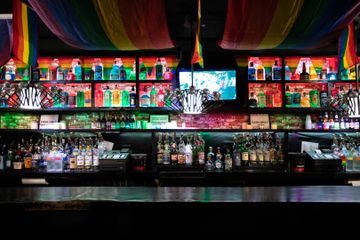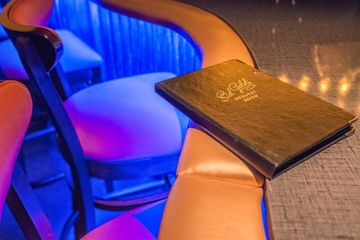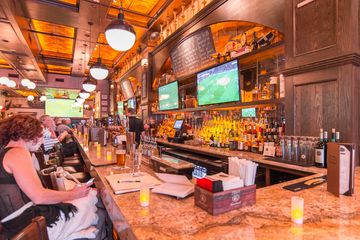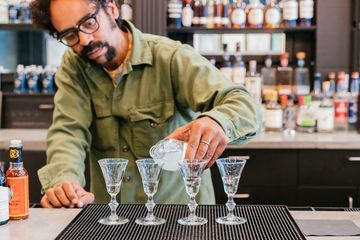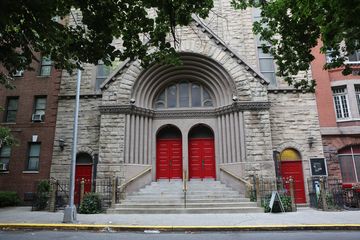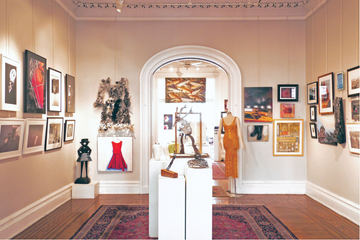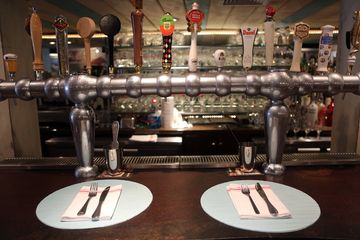Hometown pride is central to every city, whether the population is 84 or 8 million — and that is exactly the message that owner and artist Dave Ortiz strives to communicate through Our/New York Vodka. Our/Vodka is a global brand that has micro-distilleries in eight cities around the world: The “sister cities” include Berlin, Seattle, London, Detroit, Amsterdam, Los Angeles, Miami, and, of course, New York. As Ortiz says, “you could sell vodka anywhere” — but the Our/Vodka project goes beyond this to build on the unique sense of community and pride in each of its locations, and New York is no exception. With Ortiz at the helm, Our/New York Vodka screams, “This is our city. I believe in that. ” Ortiz told the Manhattan Sideways team that it “could be vodka or women’s shoes — it’s a New York product that I’m standing behind. I’m not faking the funk. ”This isn’t Ortiz’s first New York-centered endeavor. He is a self-professed ‘true blue New Yorker, ’ born and raised in New York and schooled in Fine Arts at the Fashion Institute of Technology, right down the block from Our/New York Vodka in Chelsea. Zoo York, a skate brand centered on New York skate culture, was one of Ortiz’s first big projects as employee no. 1, followed by “Dave’s Quality Meat, ” which was New York’s first ever concept store, and most recently a bike shop, all before Ortiz received the call from Our/Vodka asking him to get involved and be the local partner in Our/New York — which Ortiz has spent the last four and a half years building to perfection. When he received that phone call, Ortiz recalls, “At first I thought it was a joke because me and my friends always played practical jokes on each other. We worked with Ashton Kutcher when we owned Zoo York — so I was like, I think I'm getting punk’d. And then this person called me. . . my mind goes, ‘somebody wants me to design a box, I do a label, I throw a party, I get a few bottles of booze out of it, I call it a day’. . . He asked me if I’d be interested in meeting the founders and I said ‘yeah sure, no problem’ and then I meet these three people and I’m still thinking it's a joke, and I'm like, ‘I can't believe that whoever is doing this joke hired three Swedish actors. ’ And then they begin to tell me their idea about the Our/Vodka project — and it was quite fascinating. And for me, I fell in love with it immediately. ”The project is dependent on the unique character of each city as well as the local ingredients. Each of the seven Our/Vodka distilleries works from a common recipe. All distilleries share one ingredient, a wheat distillate which is supplied from Sweden and which is then, in its last distillation process, distilled on site in each distillery, and the rest of the ingredients are sourced as locally as possible without compromising on quality, and of course local water, in this case, local NYC tap water. Ortiz dubbed this a “glocal” organization: one that is both global and local, though his focus remains on channeling the energy of New York and his experiences there into his business. In the Our/New York bar, he makes an effort to stock products from other small and local distilleries as much as possible. Ortiz explained to us, “We don’t carry the same spirits that you would find in a regular bar. 98% of our offer is from New York state. We carry many specialty small distillers that are like us. ” And even this is part of the Our/New York Vodka mission to stand behind New York as a community, as a place with hometown pride. It makes history as the first distillery in Manhattan since prohibition, but, maybe most important, it represents a throwback to the history of diversity and community in the city. I’m all about community and friendships, ” Ortiz tells us, “and that's the thing that New York is missing right now — Everybody’s to themselves, everybody’s segregated: The bankers hang out with the bankers, the guys with the popped-shirt collars, they hang out with the popped shirt collars. . . the meatheads all hang out with the meatheads over in the meatpacking. When I grew up in the late 80's early ‘90s, everybody was forced to hang out with everybody, you know? You go to a club and there’d be bankers and models, and there was Madonna, and, you know, Andy Warhol’s walking around. And everybody was forced to hang out with everybody because that’s the way New York was. . . I personally want to recreate the fun spot that I used to hang out — where every likeminded [person] hangs out: from skaters to ballet dancers to gay people, you know, Black, white, Chinese, designers, architects, all my friends who I know. All those are the types of people that come in here and just kind of say ‘what’s up. 'Stop in and say what’s up: have a seat, try a cocktail, and have a conversation with whoever happens to sit next to you. Notice the hand-painted walls and one-of-a-kind silkscreen prints, both done by Ortiz, the rawness of the cement floors, the beautifully arranged liquors behind the bar; take a look through the glass window at the back of the space into the distilling room, the first of its kind in almost a hundred years. Within a few minutes, you’ll be feeling the hometown pride, too, no matter where you’re from.
